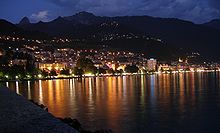Geneva-Lausanne metropolitan area
|
Geneva-Lausanne metropolitan area Métropole lémanique |
|
|---|---|
| Cantons : | |
| Area : | 3494 km² |
| Residents : | 1,298,625 (December 31, 2018) |
| Population density : | 372 inhabitants per km² |
| Website: | www.metropolelemanique.ch |
The metropolitan area of Geneva-Lausanne ( French Métropole lémanique ) is an urban economy in the Romandie (French-speaking Switzerland). This polycentric metropolitan region with the two core cities of Geneva and Lausanne is the largest metropolitan area in Switzerland after the metropolitan region of Zurich with 1,298,625 inhabitants (December 31, 2018) . The terms Geneva-Lausanne metropolitan area and Geneva-Lausanne metropolitan area are more common in German-speaking Switzerland. The region is also called Métropole lémanique after the French name of Lake Geneva and includes the cantons of Geneva and Vaud .
Demarcation

Most of the settlements are on the northern coast of Lake Geneva ( French Lac Léman ). The eastern part of this area with the cities of Vevey , La Tour-de-Peilz and Montreux is also called the Vaudois Riviera . At the south-western tip of the lake is the largest city in French-speaking Switzerland , Geneva . Lausanne, the capital of the canton of Vaud, is located in the center of the metropolitan area. The city of Yverdon-les-Bains in the north of the canton of Vaud also belongs to the Geneva-Lausanne metropolitan region.
Major cities
- Geneva ( French Genève ) is the capital of the canton of the same name and is located at the south-western end of Lake Geneva. The city itself has 201,818 inhabitants and around 645,600 inhabitants in the agglomeration . In addition to the Swiss suburbs (including Vernier , Meyrin and Carouge ), this also includes parts of the French departments of Ain and Haute-Savoie . Geneva is the seat of many international organizations, such as the United Nations . It is considered the most important international city in Switzerland and has a foreign share of 47.8 percent.
- After Geneva, Lausanne is the second largest city in French-speaking Switzerlandand the capital of the canton of Vaud . The city itself, which is also located on Lake Geneva, has 139,111 inhabitants. Almost the entire slope of Lausanne is built over today, but has some larger open spaces (parks, small forest areas). The Lausanne agglomeration therefore has around 312,000 inhabitants today. Lausanne is considered the educational center of western Switzerland. The most important educational institutions include the University of Lausanne (UNIL) and the Swiss Federal Institute of Technology Lausanne (EPFL) as well as the hotel management school École hôtelière de Lausanne (EHL). There are also numerous vocational schools, including the engineering school of the canton of Vaud.
- Montreux in the canton of Vaud has 25,984 inhabitants. The agglomeration of Vevey-Montreux, which also includes the municipalities of the canton of Friborg , has 81,484 inhabitants. Montreux is known for its exceptional location on the shore in the shelter of the mountain peaks of the Vaudois Alps, which makes this city one of the most important tourist destinations in Switzerland. Montreux is best known for the Montreux Jazz Festival , which takes place every year in July. The global hit Smoke on the Water by Deep Purple was inspired by the casino brand in Montreux in 1971.
- Vevey is located on the northeast bank of Lake Geneva and has 19,891 inhabitants. The Nestlé SA , one of the largest food companies in the world, has its headquarters in Vevey. The Alimentarium , the foodmuseumof Vevey, which is supported by Nestlé,is located on the lakeshore.
- Nyon has 21,198 inhabitants and is located on the north-west bank of Lake Geneva, between Geneva and Lausanne. Although Nyon is in the canton of Vaud, it belongs to the agglomeration of Geneva. The seat of the UEFA (European Football Association) is located in Nyon.
- Unlike most of the cities in the Geneva-Lausanne metropolitan area, Yverdon-les-Bains is not on the north bank of Lake Geneva, but on the south-western end of Lake Neuchâtel . Yverdon-les-Bains has 30,157 inhabitants and is located in the north of the canton of Vaud.
International organizations
Numerous important international organizations have their headquarters in the Geneva-Lausanne metropolitan area. Many institutions have settled in Geneva in particular.

Geneva:
- United Nations (UN)
- World Trade Organization (WTO)
- International Committee of the Red Cross (ICRC)
- World Health Organization (WHO)
Lausanne:
Nyon:
- UEFA - Association of European Football Associations
Web links
- Website of the Geneva-Lausanne metropolitan area
- The Geneva-Lausanne agglomeration - a European metropolitan area? ( PDF file; 2.85 MB)
Individual evidence
- ↑ a b Balance sheet of the permanent resident population by canton, definitive annual results, 2018. Federal Statistical Office (FSO), August 27, 2019, accessed on September 18, 2019 (definitive annual results).

